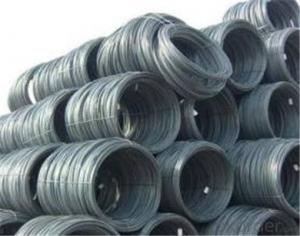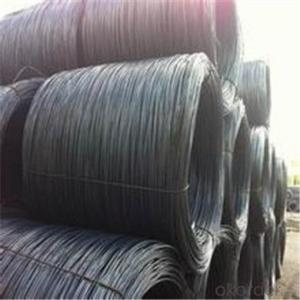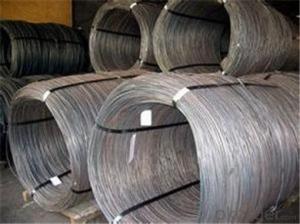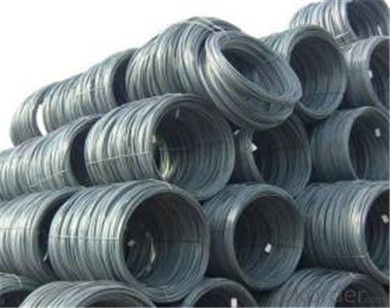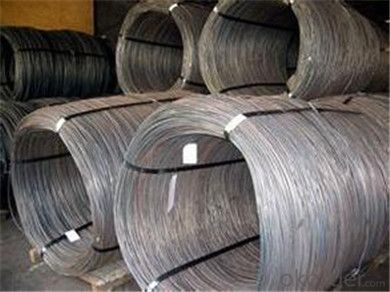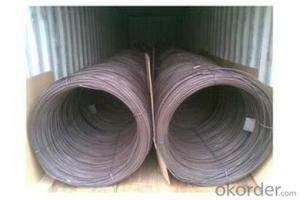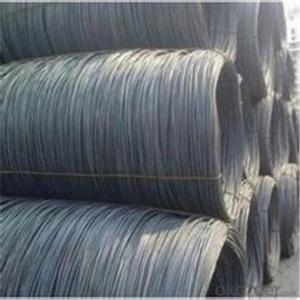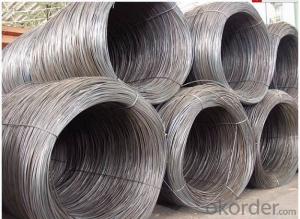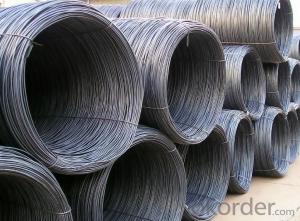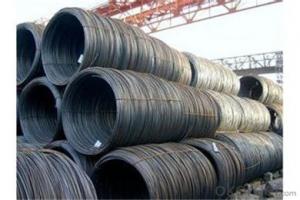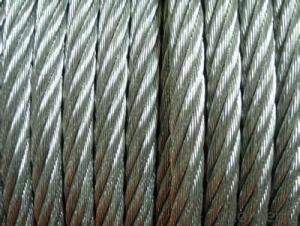SAE1008Gr Steel Wire rod 5.5mm with Best Quality
- Loading Port:
- Shanghai
- Payment Terms:
- TT OR LC
- Min Order Qty:
- 99 m.t.
- Supply Capability:
- 45555555 m.t./month
OKorder Service Pledge
OKorder Financial Service
You Might Also Like
Specification
Description of wire Rod:
wire rod:
Grade:SAE1006B/SAE1008B/SAE1018B
Size:5.5/6.5/7/8/9/10/11/12mm
Festures of wire Rod:
1. Drawn wire specialist, your wire rod solution
2. ISO9001 Certified Mill &SGS
3. Feature: machinability, high hardness, toughness, corrosion resistant
4. Clear and smooth surface, high precision and Tolerance control: ± 0.01
5. Customized service for your special requirement
6. Reasonable and more competitive mill price for you.
Specifications of wire Rod:
Grade | Chemical Composition(%) | |||||
C | Mn | Si | S | P | Cr | |
SAE1008B | 0.10max | 0.3~O.50 | 0.15max | 0.050max | 0.040 max | 0.3-0.35 |
Mechanical properties | ||||||
Yield strength(N/mm2) | Tensile strength(N/mm2) | Elongation(%) | ||||
≥195 | 315-430 | ≥30 | ||||
| Packaging Details: | (1) Coils are wrapped by 8 steel strips; (2) Wrapped by waterproof cloth; (3) Wrapped by 8 steel strips (6+2) ; (4) Added with wood pallet |
Images of wire Rod:
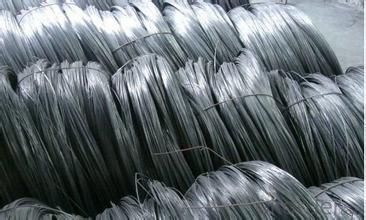
FAQ:
1. What is your package?
Packing situation: standard seaworthy packing or as customer required.
2. How long is the lead time?
Delivery time: 45 days after order confirmed.
3. What payment term do you accept?
Payment: T/T or L/C at sight.
- Q: What are the main factors affecting the market advocacy of steel wire rod?
- The main factors affecting the market advocacy of steel wire rod include supply and demand dynamics, global economic conditions, government regulations and policies, technological advancements, competition from other materials, and the overall performance and quality of steel wire rod.
- Q: What are the different wire drawing processes used for steel wire rod?
- Steel wire rod can undergo various wire drawing processes to achieve a thinner and more uniform wire with specific properties. The primary wire drawing processes for steel wire rod include: 1. Annealing: By heating the steel wire rod to a specific temperature and slowly cooling it, internal stresses are relieved. This process enhances the wire's ductility and machinability, making it easier to draw into a thinner diameter. 2. Pointing: Before drawing, the ends of the steel wire rod are typically pointed. This is done by grinding or tapering the ends to reduce their diameter, allowing for smooth passage through the drawing die. 3. Drawing: The main step in wire production is the drawing process. Here, the steel wire rod is pulled through a series of dies to decrease its diameter and increase its length. This process is usually carried out in multiple stages, with each stage employing a smaller drawing die to further reduce the wire's diameter. Drawing also enhances the wire's mechanical properties, including strength and hardness. 4. Cleaning and coating: After the wire is drawn, it is often cleaned and coated to shield it from corrosion. This involves removing residual lubricants or contaminants from the drawing process and applying a protective coating, such as zinc or copper, to enhance the wire's resistance to corrosion. 5. Heat treatment: Depending on the desired properties, the wire may undergo additional heat treatment processes after drawing. These can include quenching and tempering, which further improve the wire's strength, toughness, and flexibility. In summary, the various wire drawing processes used for steel wire rod are crucial in transforming the raw material into a final wire product with specific dimensions, mechanical properties, and surface characteristics. Each step in the process plays a vital role in ensuring the quality and performance of the end product.
- Q: What are the different surface coating removal methods for steel wire rod?
- There are several different surface coating removal methods for steel wire rod, depending on the type and thickness of the coating that needs to be removed. Some of the commonly used methods include: 1. Mechanical Methods: These methods involve physical abrasion or scraping of the coating using tools like wire brushes, sandpaper, or abrasive blasting. This method is effective for removing loose or thin coatings. 2. Chemical Stripping: Chemical stripping involves using specific chemicals or solvents to dissolve or soften the coating, making it easier to remove. The choice of chemical depends on the type of coating being removed. This method is suitable for removing thicker or stubborn coatings. 3. Thermal Stripping: This method involves subjecting the wire rod to high temperatures to burn off the coating. The heat can be applied through methods like flame torches, infrared heaters, or ovens. This method is effective for removing heat-resistant coatings. 4. Electrolysis: Electrolysis involves immersing the wire rod in an electrolyte solution and passing an electric current through it. This causes a chemical reaction that helps to break down and remove the coating. This method is suitable for removing coatings that are sensitive to heat or chemicals. 5. Laser Stripping: Laser stripping involves directing a laser beam onto the coated surface, which causes the coating to evaporate or burn off. This method is precise and effective for removing coatings without damaging the underlying material. However, it is usually more expensive and can be limited to certain types of coatings. It is important to consider factors such as cost, time, environmental impact, and safety when selecting the appropriate surface coating removal method for steel wire rod.
- Q: How is steel wire rod used in the manufacturing of wire for oil and gas pipelines?
- Steel wire rod is a crucial component in the manufacturing process of wire used for oil and gas pipelines. It serves as the primary raw material for wire production due to its strength, durability, and ability to withstand extreme conditions. The manufacturing process starts with the selection of high-quality steel wire rod, which typically consists of low carbon steel or alloy steel. This raw material is carefully chosen to meet specific requirements such as strength, corrosion resistance, and flexibility. The steel wire rod is then subjected to a series of manufacturing processes, including cleaning, descaling, and surface preparation. These steps ensure that any impurities or contaminants are removed, resulting in a clean and uniform surface. Next, the steel wire rod is heated to a specific temperature and passed through a series of dies to reduce its diameter. This process is known as drawing and is repeated several times until the desired wire diameter is achieved. The drawing process also imparts the wire with increased strength and improved mechanical properties. After drawing, the wire is annealed to relieve internal stresses and enhance its ductility. This step involves heating the wire to a specific temperature and then cooling it slowly, resulting in a more flexible and workable material. Once the wire is annealed, it undergoes another cleaning process to remove any residue or impurities that may have accumulated during manufacturing. The wire is then coated with a protective layer to enhance its corrosion resistance, typically through processes such as galvanization or polymer coating. Finally, the wire is spooled onto large reels, ready for further processing or direct use in the manufacturing of oil and gas pipelines. The wire is carefully inspected for quality, ensuring that it meets the required specifications and standards for use in these critical applications. In the manufacturing of oil and gas pipelines, the wire produced from steel wire rod plays a vital role. It is used in various applications such as reinforcement, binding, or as a structural component. The high strength and durability of the wire ensure that the pipelines can withstand the harsh operating conditions, including high pressure, extreme temperatures, and corrosive environments. Overall, steel wire rod serves as the foundation for the manufacturing of wire used in oil and gas pipelines. Its properties of strength, durability, and ability to withstand harsh conditions make it an essential material for ensuring the reliability and longevity of these critical infrastructure components.
- Q: How is steel wire rod used in the manufacturing of wire for suspension bridges?
- Steel wire rod is used in the manufacturing of wire for suspension bridges as it serves as the primary raw material. The wire rod is first drawn through a series of dies to reduce its diameter and increase its strength. This process, known as wire drawing, transforms the rod into a long, thin wire with desired mechanical properties. The resulting wire is then further processed and woven into intricate cable systems, which form the main load-bearing elements of suspension bridges. The high tensile strength and durability of steel wire make it a crucial component in ensuring the structural integrity and stability of suspension bridges, allowing them to withstand heavy loads and span long distances.
- Q: What are the different types of wire mesh for filtration made from steel wire rod?
- There are several types of wire mesh for filtration made from steel wire rod, including woven wire mesh, welded wire mesh, and expanded metal mesh. Each type has its own unique characteristics and applications in filtration systems.
- Q: What are the different types of steel wire rod coatings used for lubrication?
- There are several different types of steel wire rod coatings used for lubrication, each with its own unique properties and benefits. Some of the most commonly used coatings include: 1. Zinc Coating: Zinc coatings are widely used for lubrication purposes as they provide excellent corrosion resistance. The zinc coating acts as a sacrificial layer, protecting the underlying steel wire rod from rust and other forms of corrosion. Additionally, zinc coatings can also act as a lubricant, reducing friction between the wire rod and other surfaces. 2. Phosphate Coating: Phosphate coatings are often used as pre-treatments before applying other lubricant coatings. These coatings create a layer of phosphate crystals on the wire rod's surface, which enhances the adhesion of subsequent lubricant coatings. Phosphate coatings also improve the wire rod's wear resistance and provide a smooth surface for better lubrication. 3. Polymer Coating: Polymer coatings are commonly used for lubrication purposes due to their excellent friction-reducing properties. These coatings are typically made of synthetic polymers such as polytetrafluoroethylene (PTFE) or polyamide. Polymer coatings create a low-friction surface that reduces wear and tear, increases the lifespan of the wire rod, and improves its performance in various applications. 4. Wax Coating: Wax coatings are another popular choice for lubricating steel wire rods. These coatings are typically made of natural or synthetic waxes and are applied by either dipping or spraying the wire rod. Wax coatings provide a protective layer that reduces friction, prevents rust, and improves the wire rod's handling during manufacturing and processing. 5. Oil Coating: Oil coatings are commonly used for temporary lubrication of steel wire rods during storage and transportation. These coatings are typically applied as a thin layer of oil that provides immediate lubrication and corrosion protection. Oil coatings are easily applied and can be removed easily before further processing or use. It is important to note that the selection of a specific coating depends on various factors, including the desired level of lubrication, corrosion resistance, and the specific application of the wire rod. Manufacturers often consider factors such as cost, performance requirements, and environmental considerations when choosing the appropriate coating for steel wire rods.
- Q: How does the cost of steel wire rod compare to other materials?
- Compared to other commonly used materials for similar applications, steel wire rod often has a lower cost. Its wide availability and large-scale production contribute to its relatively affordable price. Furthermore, steel's high recyclability adds to its cost-effectiveness. When compared to alternatives like aluminum or copper wire rod, steel wire rod is generally more economical. However, it is crucial to take into account factors such as market demand, quality, and specific application needs as these can affect the cost of steel wire rod.
- Q: How is steel wire rod used in the production of springs for mattresses?
- Steel wire rod is used in the production of springs for mattresses by being coiled and formed into the spring shape. The wire rod provides strength and flexibility, allowing the springs to support weight and provide comfort when used in mattresses.
- Q: What are the different annealing processes used for steel wire rod?
- The different annealing processes used for steel wire rod include full annealing, spheroidization annealing, and process annealing. Full annealing involves heating the wire rod to a temperature above its critical temperature and then slowly cooling it to room temperature to soften it and improve its ductility. Spheroidization annealing is a type of full annealing that is specifically used for high carbon steel wire rod to transform its brittle cementite structure into spherical carbides, enhancing its machinability and reducing the risk of breakage. Process annealing, on the other hand, is a partial annealing process that is performed on cold-worked wire rod to relieve internal stresses and restore some of its ductility without affecting its mechanical properties.
Send your message to us
SAE1008Gr Steel Wire rod 5.5mm with Best Quality
- Loading Port:
- Shanghai
- Payment Terms:
- TT OR LC
- Min Order Qty:
- 99 m.t.
- Supply Capability:
- 45555555 m.t./month
OKorder Service Pledge
OKorder Financial Service
Similar products
Hot products
Hot Searches
Related keywords
